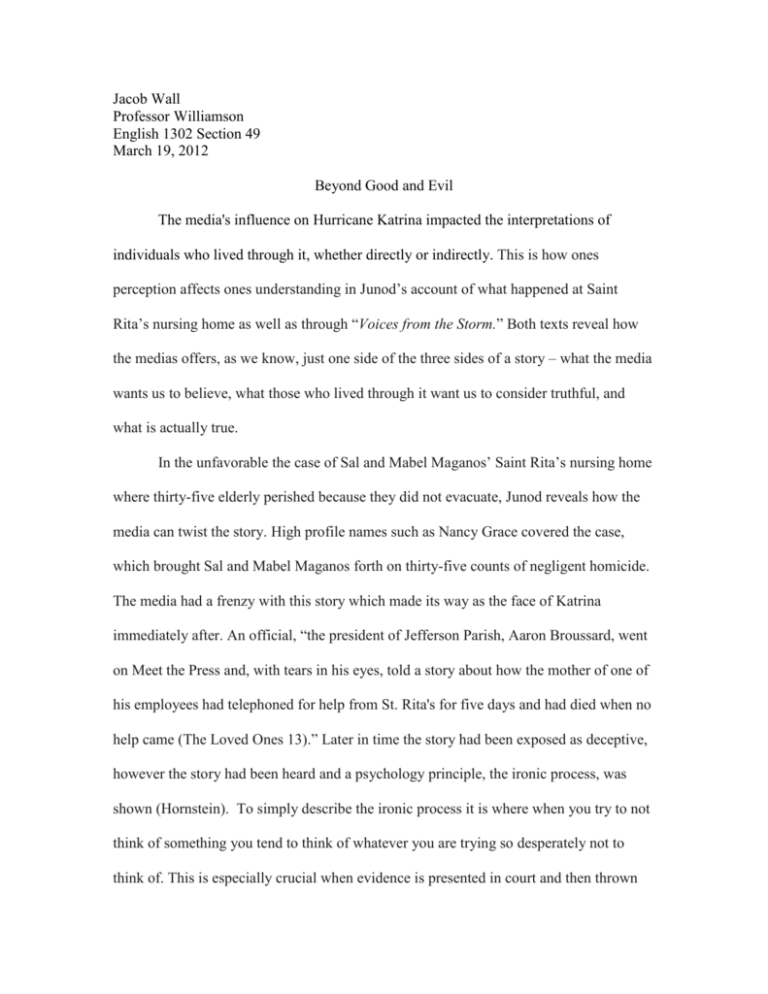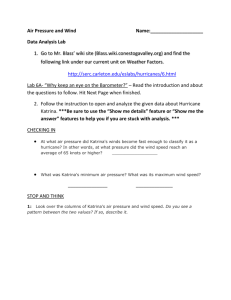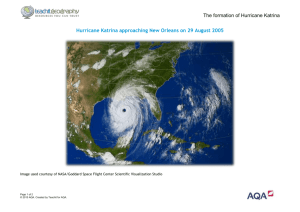KatrinaPaper
advertisement

Jacob Wall Professor Williamson English 1302 Section 49 March 19, 2012 Beyond Good and Evil The media's influence on Hurricane Katrina impacted the interpretations of individuals who lived through it, whether directly or indirectly. This is how ones perception affects ones understanding in Junod’s account of what happened at Saint Rita’s nursing home as well as through “Voices from the Storm.” Both texts reveal how the medias offers, as we know, just one side of the three sides of a story – what the media wants us to believe, what those who lived through it want us to consider truthful, and what is actually true. In the unfavorable the case of Sal and Mabel Maganos’ Saint Rita’s nursing home where thirty-five elderly perished because they did not evacuate, Junod reveals how the media can twist the story. High profile names such as Nancy Grace covered the case, which brought Sal and Mabel Maganos forth on thirty-five counts of negligent homicide. The media had a frenzy with this story which made its way as the face of Katrina immediately after. An official, “the president of Jefferson Parish, Aaron Broussard, went on Meet the Press and, with tears in his eyes, told a story about how the mother of one of his employees had telephoned for help from St. Rita's for five days and had died when no help came (The Loved Ones 13).” Later in time the story had been exposed as deceptive, however the story had been heard and a psychology principle, the ironic process, was shown (Hornstein). To simply describe the ironic process it is where when you try to not think of something you tend to think of whatever you are trying so desperately not to think of. This is especially crucial when evidence is presented in court and then thrown Wall 2 out, the jury has already heard it and thus it stays in their mind although it has been thrown out. No matter the fact that what Aaron Broussard said was fabricated, it damaged the reputations of Sal and Mabel Magano further and propelled the story to be spread nationwide. The media showed only negatives; without any mention of the good deeds that the Magano’s had done for all of the previous hurricanes. The Magano’s were time and time again a safe place for those who wanted to wait out the hurricane. The Magano’s had never been a place to turn away anyone who needed refuge. Junod reveals that there are many different ways one can interpret the unfortunate event of Saint Rita, from an internal attribution, concluding that a behavior was caused by one’s internal disposition or personality, and an external attribution, concluding that a behavior was caused by an external situation (Hornstein). When looked from an internal attribution, as the media portrayed initially, the Maganos chose not to evacuate because it would cost them money and if evacuated they would not collect the ninety-five dollars per day that they were paid to take care of the residents (The Loved Ones 14). This was refuted by the Maganos on the basis that they had “always stayed (The Loved Ones 15)” and because they “loved their residents as much as anyone did, even their families (The Loved Ones 15).” If one looks at the situation from an external attribution you can deduce that they chose to stay due to twenty years of not leaving, pressure of an impeding hurricane, trust in the levees, and the lack of actual government assistance. Junod’s article is similar to Voices from the Storm as both articles show a side that the media lacked to report on. Voices from the Storm replays Dan Brights’ unjust response by officials towards inmates. Dan Bright was wrongfully convicted of firstdegree murder back in 1996, however a decade later was exonerated. As he was driving Wall 3 around New Orleans he was arrested due to an outstanding warrant for domestic violence. Sadly he, as well as all other inmates, were put through many acts of injustice. However, Dan Bright was singled out due to his past conviction, although overturned, restricted from his legal right to speak to his lawyer, put in solitary confinement for no valid reason, and held after past the thirty day maximum holding time due to the domestic violence warrant being a misdemeanor. The media was blinded by lies of officials stating that they had gotten everybody out, causing a loss of truth. While the officers reported this, CNN was displaying pictures, unknowingly, of the prisoners on the bridge in lines. What really happened is that the guards abandoned the prisoners, viewing them as less than human where dogs were worth more than them. This can be seen when guards would provide water to the dogs before the inmates (Vollen & Ying 96). As you may have noticed, this probably was not the very least of what happened. The guards restricted the ability for inmates to use the bathroom so they were forced to defecate on themselves near hundreds of others. This disconnect of truth is easily viewed, but only after the fact, where the “truth” that the media had reported had been spread around and when articles like Voices from the Storm and The Loved Ones are written to refute what western media reports and provide a better sense of truth from another side of the story. It is up to you, as a reader, to interpret the “real” truth, if that is even possible. Careful examination of the sources reveals that media can have positive and negative impacts to individuals living through disaster, whether natural in the case of Hurricane Katrina or not. The media can provide an insightful, but often one sided, viewpoint that is focused on receiving the highest ratings and having the best viewer retention rate. As Susan Moeller explains in her article, “”Regarding the Pain of Others:” Wall 4 Media, Bias, and the Coverage of International Disasters” stories that are picked up by major news outlets are often ones where Westerners are involved, thus increasing ratings (Moeller 177). Moeller claims that if Westerners are not involved in a disaster, the media will not report it (Moeller 178). This can be explained due to the inherent fact that it is human nature to be selfish. We only, instinctively, care for those who we are directly connected with, in this case, westerners. This leaves many stories that are not picked up, such as the Iran earthquake that killed 60,000 (Moeller 176). The positive effects of the media can be seen in how the government planned to deal with later disasters due to the outrage of citizens. Provided the feedback that the government had John Facella’s explains how the government has changed their way in which they react to natural disasters, or any disasters at that point, by providing better communication, food supply, law enforcement, etc (Facella). This is shown through awareness programs in cities that in the event of a disaster be prepared for delays in emergency response and to look after yourself, a more stringent schedule for law enforcement to prevent too much stress and subsequent poor decision making in times of disaster, as well as an increase in alternative power for major infrastructure. It is hard, if not impossible, to get the whole truth. That being said, by reading between the lines of each story and carefully gathering from all perspectives of the story, one can unscramble all that is shown to us daily and get to their own conclusion. Wall 5 Works Cited Facella, John. "Lessons from Hurricane Katrina." Mobile Radio Technology (2006).LexisNexis Academic. Web. 25 Mar. 2012. <http://www.lexisnexis.com/hottopics/lnacademic/?shr=t&csi=158695&sr=HLE AD(Lessons+from+Hurricane+Katrina)+and+date+is+July,%202006>. Hornstein, Susan. "Emotional Experiences." Hyer Hall, University Park, Texas. 19 March 2012. Lecture. Junod, Tom. “The LOVED ONES.” Esquire 146.3 (2006) : 216-262. Academic Search Complete. Web. 16 Feb. 2012. Moeller, Susan D. "Regarding the Pain of Others': Media, Bias and the Coverage of International Disasters." Journal of International Affairs 59.2 (2006): 173-96. Print. Vollen, Lola, Chris Ying, Dave Eggers, Stacy Parker. Aab, Mary Beth. Black, Colin Dabkowski, Billy Sothern, Andy Young, and Lart Cognac. Voices from the Storm: The People of New Orleans on Hurricane Katrina and Its Aftermath. San Francisco: McSweeney's, 2006. Print.





